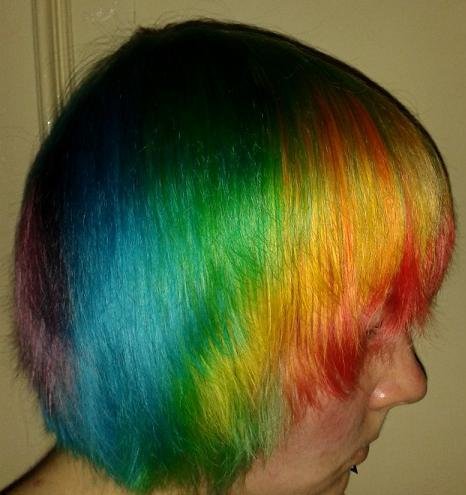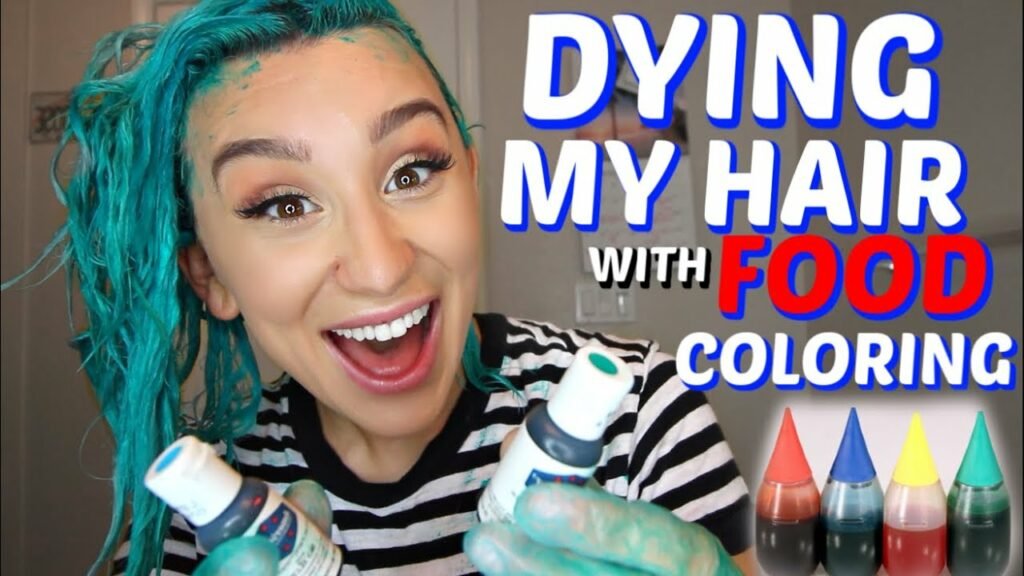Yes, you can dye your hair with food coloring. Food coloring can be used to temporarily dye your hair, but it may not produce long-lasting or vibrant results.
It is important to note that natural hair colors and the condition of your hair can impact the end result. When using food coloring, it’s advisable to conduct a patch test and consider consulting a professional hairstylist. Understanding the process and potential outcomes can help you achieve the desired results while minimizing any potential damage to your hair.
We’ll explore the possibilities and limitations of using food coloring as a hair dye, as well as provide tips for the application process.

Contents
- 1 Understanding The Basics Of Hair Dyeing
- 2 Exploring The Potential Of Food Coloring
- 3 Safety Precautions And Risks
- 4 Tips And Techniques For Using Food Coloring
- 5 Factors To Consider Before Dyeing With Food Coloring
- 6 Frequently Asked Questions
- 6.1 Can I Dye My Hair With Food Coloring Without Damaging It?
- 6.2 What Are The Best Colors To Dye Your Hair With Food Coloring?
- 6.3 How Long Will The Color Last If I Dye My Hair With Food Coloring?
- 6.4 Can I Mix Different Food Colors To Create A Custom Hair Dye Shade?
- 6.5 Are There Any Risks Or Precautions I Should Consider When Dyeing My Hair With Food Coloring?
- 7 Conclusion
Understanding The Basics Of Hair Dyeing
In this section, we will delve into the fundamentals of hair dyeing, demystifying the process and shedding light on the different methods and products available. Understanding the basics of hair dyeing is crucial for anyone considering using food coloring as a hair dye alternative. Let’s explore the inner workings of hair dye and its alternatives.
How Hair Dye Works
Hair dye works by penetrating the hair shaft and depositing color into the hair cuticle, altering the hair’s natural pigment. The process typically involves opening the hair cuticle to allow the dye to enter and deposit color. Permanent hair dyes use chemicals such as ammonia and hydrogen peroxide to lift the natural hair color and introduce the new pigment. On the other hand, semi-permanent and temporary dyes only coat the hair shaft, without the need for the harsh chemicals present in permanent dyes.
Traditional Hair Dyes Vs. Alternative Methods
Traditional hair dyes are formulated with a variety of chemicals that have been refined over the years to offer long-lasting and vibrant color. However, many individuals are turning to alternative methods, such as using food coloring, to achieve unique and temporary hair colors. While traditional hair dyes are designed to penetrate the hair and last for a longer duration, alternative methods like food coloring can offer vibrant hues without the use of harsh chemicals, making them a popular choice for those seeking temporary or non-toxic options.
Exploring The Potential Of Food Coloring
When it comes to hair dye, the possibilities are seemingly endless. With so many types of dyes available, it’s natural to wonder about using alternative options, including food coloring. Many people have experimented with using food coloring as a hair dye, often with mixed results. In this article, we’ll explore the potential of food coloring for hair dye, discussing its properties, benefits, and drawbacks.
Properties Of Food Coloring
Food coloring is a versatile and accessible product that comes in a variety of vibrant hues. It is designed to be safe for consumption, making it a popular choice for adding color to food and drinks. The properties that make food coloring appealing for culinary use, such as its vibrant pigmentation and non-toxic nature, also make it an intriguing option for hair dye.
Benefits And Drawbacks
- Benefits:
- 1. Versatility: Food coloring offers a wide range of colors, providing individuals with numerous options for expressing their personal style.
- 2. Temporary: Unlike traditional hair dye, food coloring typically produces a temporary or semi-permanent effect, allowing for experimentation without long-term commitment.
- 3. Readily Available: Food coloring is easily accessible at most grocery stores, making it convenient for those looking to experiment with DIY hair color.
- Drawbacks:
- 1. Staining: Improper application or use of food coloring can lead to staining on the scalp, skin, and clothing.
- 2. Less Predictable Results: Achieving desired results with food coloring can be unpredictable, as different hair types and colors may react differently to the dye.
- 3. Lacks Conditioning Properties: Unlike professional hair dyes, food coloring typically lacks conditioning agents, which can affect the overall health and texture of the hair.
Safety Precautions And Risks
When we consider using food coloring to dye hair, it is essential to understand the safety precautions and potential risks associated with this unconventional method of hair coloring. While food coloring may seem like a harmless and creative way to change your hair color, there are important factors to consider in order to protect the health and integrity of your hair. Let’s delve into the potential risks and safety precautions for using food coloring on your hair.
Potential Risks Of Using Food Coloring On Hair
Before opting for food coloring to change your hair color, it is important to be aware of the potential risks involved. Food coloring may not be designed for use on hair, and its chemical composition differs from traditional hair dyes. As a result, there are several risks to consider:
- Discoloration: Food coloring may interact unpredictably with the natural pigments in your hair, leading to unexpected and unintended color outcomes.
- Damage: The ingredients in food coloring may not be suitable for hair and can cause dryness, brittleness, or damage to the hair shaft.
- Allergic Reactions: Some individuals may be sensitive or allergic to certain food coloring ingredients, leading to skin irritation or other adverse reactions.
- Staining: Food coloring has the potential to stain not only your hair but also your scalp and skin, creating a messy and difficult-to-remove situation.
Safety Precautions To Consider
While the idea of using food coloring as a hair dye may be tempting, taking necessary safety precautions is crucial to avoid potential negative outcomes. Here are some safety precautions to keep in mind before using food coloring on your hair:
- Patch Test: Always perform a patch test by applying a small amount of food coloring to a discreet area of your skin to check for any allergic reactions.
- Protective Gear: Wear gloves, old clothing, and use a protective barrier such as petroleum jelly around the hairline to prevent staining on your skin and clothes.
- Hair Porosity: Assess the porosity of your hair before applying food coloring, as porous hair may absorb color differently and result in uneven or patchy color.
- Hair Condition: Ensure that your hair is in a healthy condition before using food coloring to minimize the risk of damage and breakage.
Tips And Techniques For Using Food Coloring
When it comes to dyeing your hair with food coloring, there are various tips and techniques to ensure a successful and vibrant result. The application methods and achieving desired results are crucial factors to consider. By understanding the best practices for using food coloring, you can enjoy experimenting with vibrant and unique hair colors while minimizing the potential for damage.
Application Methods
Applying food coloring to your hair is a creative and cost-effective way to experiment with bold color statements. Here are some popular application methods:
- Mixing with Conditioner: To create a less intense and more temporary color, mix food coloring with white conditioner. This method is suitable for achieving pastel tones and for those looking for a non-permanent option.
- Direct Application: Apply food coloring directly onto sections of your hair for a bolder and more permanent effect. It’s essential to use gloves and protect your clothing to prevent unwanted staining.
- Temporary Hair Chalk: Blend food coloring with cornstarch or flour to create a temporary hair chalk. This method allows for easy application and removal, making it ideal for temporary color experiments.
Achieving Desired Results
When using food coloring to dye your hair, achieving the desired results involves considering a few important factors:
- Hair Porosity: The porosity of your hair affects how it absorbs color. High porosity hair may take up color more easily, while low porosity hair may require additional preparation or heat to open the cuticle for better absorption.
- Color Mix Ratio: Experiment with different ratios of food coloring to create the desired color intensity. It’s important to conduct a strand test to ensure the chosen color will turn out as expected.
Factors To Consider Before Dyeing With Food Coloring
Factors to Consider Before Dyeing with Food Coloring
Hair Type And Color
When considering dyeing your hair with food coloring, it’s important to take into account your hair type and natural color. Different hair types and textures may react differently to food coloring, and the final results can vary. While light-colored or bleached hair is more likely to show the color vividly, darker hair may require more intense and prolonged application or possibly a pre-lightening treatment to achieve the desired effect.
Aftercare And Maintenance
After dyeing your hair with food coloring, proper aftercare and maintenance are essential to preserve the color and keep your hair healthy. Using shampoos and conditioners specifically formulated for color-treated hair can help maintain the vibrancy of the color. Additionally, limiting exposure to UV rays and heat styling tools can prevent fading. Regular touch-ups may be necessary to maintain the desired color, so be prepared for ongoing maintenance.
Frequently Asked Questions
Can I Dye My Hair With Food Coloring Without Damaging It?
Yes, you can dye your hair with food coloring without causing damage. However, the color results may vary based on your natural hair color.
What Are The Best Colors To Dye Your Hair With Food Coloring?
The best colors to dye your hair with food coloring are vibrant and dark shades such as red, blue, and purple. These colors show up well on light-colored hair.
How Long Will The Color Last If I Dye My Hair With Food Coloring?
The color from food coloring typically lasts for a few washes. However, it may linger longer on light or bleached hair.
Can I Mix Different Food Colors To Create A Custom Hair Dye Shade?
Yes, you can mix different food colors to create unique hair dye shades. Experiment cautiously for the desired color intensity.
Are There Any Risks Or Precautions I Should Consider When Dyeing My Hair With Food Coloring?
When using food coloring to dye hair, be cautious of staining on skin and clothing. Conduct a patch test and use gloves to avoid staining.
Conclusion
Dyeing your hair with food coloring can be a fun and unique way to add a pop of color to your look. However, it’s important to perform a patch test and consider the potential drawbacks before proceeding. Consulting with a professional hair colorist is also recommended for desired results.
Experimenting with food coloring can be exciting, but remember to proceed with caution.

